Country guides

Things to do in Cambodia
Cambodian attractions are unique, moulded by the country's culture and history, making sightseeing a real Khmer experience. The fact that Cambodia has only recently emerged as a popular tourist destination has ensured that visitors can still get an authentic experience of this ancient culture. Most people who holiday in Cambodia are enticed by the impressive ancient temple city of Angkor in Siem Riep. Once hooked by the ancient attractions however, tourists will discover that the more recent history of the Khmer Rouge, though tragic and frightening, is intriguing in its own way. The more sombre Phnom Penh attractions, such as the Killing Fields and Tuel Sleng Prison Museum, are contrasted to the vibrant Central Market and to the peacefulness of the river front and lake side, not to mention the habitually friendly local population. For even more relaxation, the beach towns of Kep and Sihanoukville on the Cambodian coast are well worth a visits, if only to catch a glimpse of the rare Irrawaddy river dolphins of the northeast.
Getting around Cambodia can be challenging. Visitors should bear in mind that in monsoon season - June to October - the roads can get really muddy, making travel outside of the main centres more difficult. The rest of the year travel can be dusty but is more manageable.
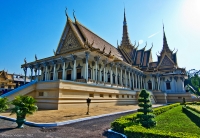
The Royal Palace
The Royal Palace is one of the principal attractions of Phnom Penh and contains the best examples of 20th-century Khmer architecture in the city. It has remained the official resid…
The Royal Palace
The Royal Palace is one of the principal attractions of Phnom Penh and contains the best examples of 20th-century Khmer architecture in the city. It has remained the official residence of the kings of Cambodia since 1860. Set among the perfectly manicured gardens are the exquisite Throne Hall, the Elephant Pavilion, the Royal Treasury and the Chan Chhaya Pavilion, built especially for performances of classical Cambodian dance.
Although much of the palace is off-limits, the Silver Pagoda with its floor of silver tiles is open to visitors. The internal walls are decorated with frescoes depicting episodes of the Ramayana myth, painted in 1903 by 40 Khmer artists. It is also called the Pagoda of the Emerald Buddha, a tribute to the magnificent baccarat crystal image of the Emerald Buddha that sits in the centre.
There are other intricately carved Buddha images on display, notably the life-size solid gold statue that stands in front of the pedestal, decorated with 9,584 diamonds. Visitors should remember to dress conservatively and respectfully when visiting the Royal Palace; bare shoulders or legs are frowned upon within the complex.
Address 63, Street 348, Sangkat Toul Svay Prey II, Khan Chamkamorn, Phnom Penh
Opens Daily 8am-10.30am, 2pm-5pm.
Admission
$10 per person.
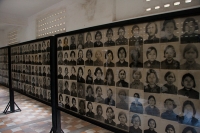
Tuol Sleng Museum
When the Khmer Rouge came into power in 1975, they commandeered and converted a secondary school into a primitive prison where they detained and tortured anyone suspected of anti-r…
Tuol Sleng Museum
When the Khmer Rouge came into power in 1975, they commandeered and converted a secondary school into a primitive prison where they detained and tortured anyone suspected of anti-revolutionary behaviour. Between 1975 and 1979, an estimated 20,000 victims were imprisoned in Security Prison 21, or S21 as it was known. The building appears almost exactly as the fleeing Khmer Rouge left it, serving as a testimony to the crimes and atrocities of the organisation.
It is a tremendously moving and sombre experience, the museum's photographs, instruments of torture and bloodstained walls giving an idea as to the pain and horror borne by the Cambodian people. Thousands of victims were transported from here to the extermination camp outside the city, Choeung Ek (The Killing Fields). There are some first person accounts on display at the museum, despite the fact that, of the estimated 20,000 prisoners incarcerated in S21, there are only 12 known survivors.
Address Corner of Street 113 and Street 350, Boeng Keng Kang
Website tuolsleng.gov.kh
Opens Daily from 8am-5pm.
Admission
$3 per person.
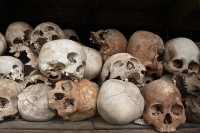
Choeung Ek (The Killing Fields)
The Cambodian genocide during the late 1970s ranks as one of the great horrors of modern history. Under Pol Pot, an estimated 1.7 million people were either ruthlessly slaughtered …
Choeung Ek (The Killing Fields)
The Cambodian genocide during the late 1970s ranks as one of the great horrors of modern history. Under Pol Pot, an estimated 1.7 million people were either ruthlessly slaughtered by the Khmer Rouge, or died of starvation in the communal fields. Choeung Ek was the extermination camp where the prisoners from S21 (now the Tuol Sleng Museum) were executed. Also known as the Killing Fields, after the movie of the same name, this football-field-sized area contains the mass graves of about 20,000 people.
A tall Memorial Stupa has been constructed to commemorate the dead with more than 8,000 human skulls displayed behind the glass. At the entrance, a handwritten sign in Khmer and English summarises the atrocities perpetrated by the Khmer Rouge. As a reminder of the reality of this great tragedy, human bones are still frequently unearthed by heavy rains in the area, and many of the tour guides have personal stories to tell about their experiences during Pol Pot's reign. A visit to the Killing Fields is harrowing and perhaps not suitable for children, but remains one of the most popular tourist attractions in Cambodia.
Address Just over nine miles (15km) southwest of Phnom Penh
Opens Daily 8am-5.30pm
Admission
$3 entrance fee per person, $3 per audioguide.
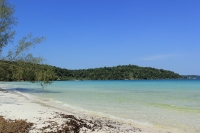
Sihanoukville
While this beach town isn't nearly as famous as those found along Thailand's pristine coast, it does make a great tourist getaway. Sihanoukville is the country's only deep water po…
Sihanoukville
While this beach town isn't nearly as famous as those found along Thailand's pristine coast, it does make a great tourist getaway. Sihanoukville is the country's only deep water port, making much of the town industrial and unattractive to tourists. But the coastal city is surrounded on three sides by the Bay of Thailand and there are several secluded tourist beaches with all the requisite trappings: dishevelled beach bars, guesthouses, and smiling hawkers. As there isn't much to do in town, it is worth the extra money to stay in the quaint beachside accommodation.
Daytime activities include swimming, fishing, snorkelling, scuba diving, and boat trips to the nearby islands. There are also several Buddhist temples to be explored in the area and the Ream National Park is only 11 miles (18km) away. Most hotels and guest houses offer transport and day passes for visiting the National Park. Nightly beach barbecues prepare great food and offer cheap beer. The government is said to have plans to develop the area for larger resorts which may well ruin its laid-back beach charm in years to come. Regular daily buses provide a three to four hour journey to and from Phnom Penh, along Cambodia's best road. There is also a ferry connecting to Koh Kong, the Cambodian/Thailand border.
Address 115 miles (185km) southwest of Phnom Penh
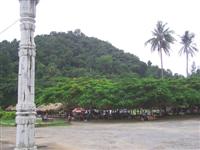
Krong Kep
From Phnom Penh, a great excursion is the formerly lavish resort town of Krong Kep. Once a famous high-society destination called The Pearl of the Orient, Kep is now more of a rust…
Krong Kep
From Phnom Penh, a great excursion is the formerly lavish resort town of Krong Kep. Once a famous high-society destination called The Pearl of the Orient, Kep is now more of a rustic off-the-beaten-track fishing village. The Khmer Rouge wreaked havoc on the town, but the ruined villas of the rich now add to Kep's crumbling mystique. A beautiful coastal road, beautiful beaches, jungled mountains and the nearby Rabbit Island ensure that Krong Kep continues to draw visitors to its shores.
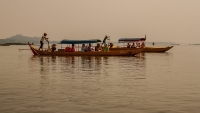
River Dolphins
The Irrawaddy river dolphins inhabit a 118-mile (190km) stretch of the Mekong River. These odd but delightful creatures are in danger of extinction, with recent population estimate…
River Dolphins
The Irrawaddy river dolphins inhabit a 118-mile (190km) stretch of the Mekong River. These odd but delightful creatures are in danger of extinction, with recent population estimates as little as 85, but are fortunately now protected. They are sometimes spotted from the riverbank but many tourists opt to rent small boats to get closer to them. The local oarsmen retain a healthy distance from surfacing animals but viewers can get close enough to recognise individual characteristics and see the famous dolphin smiles.
Address Kratie, about five or six hours from Phnom Penh
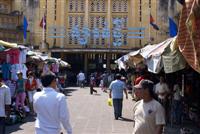
Central Market (Psah Thmey)
A trip to Phnom Penh would be incomplete without a visit to Central Market and its quirky architecture. This famous Art Deco building consists of a huge central dome with four wing…
Central Market (Psah Thmey)
A trip to Phnom Penh would be incomplete without a visit to Central Market and its quirky architecture. This famous Art Deco building consists of a huge central dome with four wings spilling out into large halls. Psah Thmey contains countless stalls run by more than 3,000 merchants. When the market was first opened in 1937, it was said to be the biggest market in Asia. Visitors can buy almost everything here (make sure to haggle), including souvenirs, clothes, fresh produce, books, flowers, postcards, antiques and a vast selection of jewellery. Its central location is walkable from almost anywhere and is a recognisable landmark from many of Phnom Penh's main roads.
Address Neayok Souk, Phnom Penh
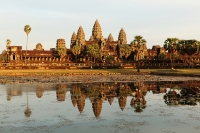
Temples of Angkor
The magnificent Temples of Angkor are iconic symbols of Cambodia, the spectacular complex a vivid vestige of the ancient Khmer Empire. Built between the 9th and 13th centuries, mor…
Temples of Angkor
The magnificent Temples of Angkor are iconic symbols of Cambodia, the spectacular complex a vivid vestige of the ancient Khmer Empire. Built between the 9th and 13th centuries, more than 100 temples have been uncovered as evidence of this impressive ancient civilisation and one of the biggest cities of its time. The complex's ancient ruins, well-preserved temples and stone monuments take a few days to explore in its entirety.
An impressive Hindu temple surrounded by a moat, Angkor Wat is the largest religious monument ever built and acknowledged as one among the greatest marvels of humankind. The walled Royal City of Angkor Thom is home to the Bayon Temple and its huge stone faces, another fascinating attraction.
If budget allows, visitors can see Angkor from the air in a hot air balloon or helicopter. It is particularly special to see the temple complex at sunrise and sunset, and it is best to avoid going during the midday heat. Also note that visitors are expected to dress respectfully and ticket vendors may refuse entry to those showing too much skin.
Address Three miles (5km) outside Siem Reap.
Opens Daily 5.30am-6pm.
Admission
$37 for 1 day ticket, $62 for 3 day ticket, $72 for 7 day ticket. Free for children under 12.
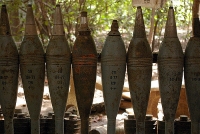
Aki Ra's Landmine Museum
The Aki Ra Museum provides a jarring counterpoint to the ancient Khmer glories on display at Angkor Wat, instead showcasing the more recent horrors of Cambodia's political and soci…
Aki Ra's Landmine Museum
The Aki Ra Museum provides a jarring counterpoint to the ancient Khmer glories on display at Angkor Wat, instead showcasing the more recent horrors of Cambodia's political and social upheavals. Founded by a former Khmer Rouge child soldier, the museum provides a clear and compelling account of this troubled time, and the appalling legacy of landmines and unexploded ordinance that remain a blight on the lives of Cambodian people. Despite ongoing efforts to find and defuse these sleeping weapons, it is estimated that about five million still remain. The museum teaches visitors how to recognise mines and what to do should they encounter them.
Address Located four miles (6km) south of Banteay Srey Temple, within the Angkor Wat Archaeological Park.
Website www.cambodialandminemuseum.org
Opens Open daily 7.30am-5pm.
Admission
$5 adult, free for children, other concessions available.


